The Wipers Times Exposé Addendum: Conclusive Proof, the Letters of Thomas Moore Emmanuel Ward, and Other Contributors Identified
Following on from the previous article, I got my first lead regarding tracking down the identity of Violet, of 'Violets Chronicle of Fashion', in the form of letters written by Thomas Moore Emmanuel Ward (1895-1947). Ward was a Lieutenant in the 12th Battalion (Pioneers) Sherwood Foresters as well as a contributor to the Wipers Times.
Ward was a prolific letter writer, and The Nottinghamshire Archive holds 227 letters sent to his parents Elizabeth and Thomas who lived in Woodthorpe, Nottingham, between 20 February 1916 and 14 July 1918.1
The Proof
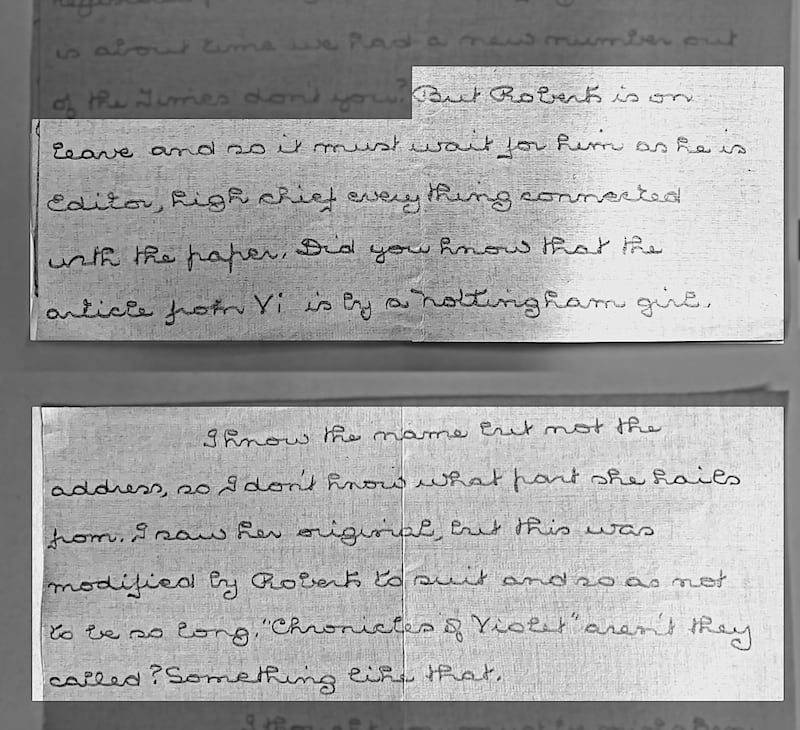
The letters provided two important pieces of evidence regarding the identity of Violet. First, I was concerned that the exchange between the Wipers Times and Tatler — via Sabretache's column 'Pictures in the Fire' — could have been a stunt. Ward makes two direct references to the exchange — on 16 and 28 May 1916 — and includes the relevant copies of the Tatler articles within his letters. Nothing in these mentions suggests anything other than the exchange was genuine — he even raves about Sabretache's review of the Wipers, commenting: 'Would do fine for a preface to a bound volume'.2
More important is a letter from 11 October 1916 (Figure 1) which says:
Did you know that the article from Vi is by a Nottingham Girl. I know the name but not the address, so I don't know what part she hails from. I saw her original, but this was modified by Roberts to suit and so as not to be so long, 'Chronicles of Violet; aren't they called? Something like that.3
Considering the previous evidence, I believe it is conclusive that there was a female writer on the Wipers Times, and while he does not mention her full name — given he points out the Nottingham connection, it is therefore reasonable to assume that it was Dorothy Violet Hall identified in the original article — it would be good to find, in the future, a name check in Dorothy Hall's favour to close the matter.
Ward's letters provided not only a view into the world of the Wipers Times, but also the identity of several other individuals involved in the magazine.
Thomas Moore Emmanuel Ward
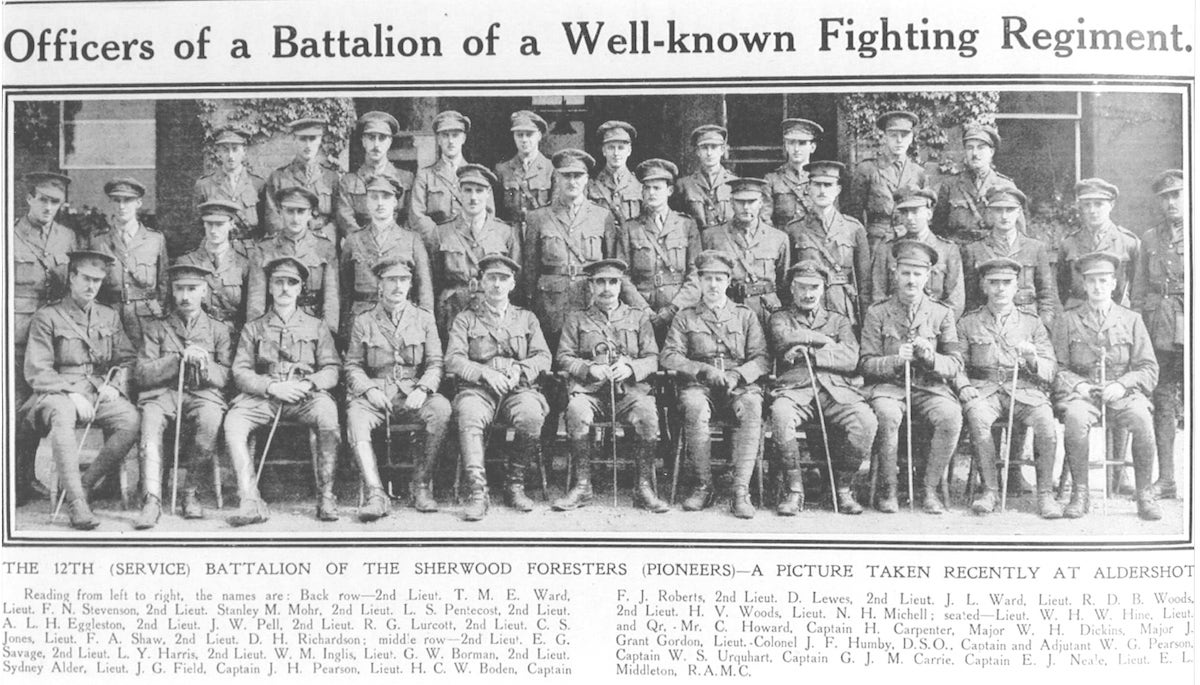
Back row (left to right)
2nd Lieut. T.M.E. Ward, Lieut. F. N. Stevenson, 2nd Lieut. Stanley M. Mohr, 2nd Lieut. L. S. Pentecost, 2nd Lieut. A. L. H. Eggleston, 2nd Lieut. J. W. Pell, 2nd Lieut. R. G. Lurcott, 2nd Lieut. C. S. Jones, Lieut. F. A. Shaw, 2nd Lieut. D. H. Richardson.
Middle Row
2nd Lieut. E. G. Savage, 2nd Lieut. L. Y. Harris, 2nd Lieut. W. M. Inglis, Lieut. G.W. Borman, 2nd Lieut. Sydney Alder, Lieut. J. G. Field, Captain J. H Pearson, Lieut. H. C. W. Boden, Captain F. J. Roberts, 2nd Lieut. D. Lewes, 2nd Lieut. J. L. Ward, Lieut. R. D. B. Woods, 2nd Lieut. H. V. Woods, Lieut. N. H. Mitchell.
Seated
Lieut. W. H. W. Hine, Lieut. and Qr, - Mr, C. Howard, Captain H. Carpenter, Major W. H. Dickins, Major J. Grant Gordon, Lieut.-Colonel J.F. Humby, D.S.O., Captain and Adjutant W. G. Pearson, Captain W. S. Urquhart, Captain G. J. M. Carrie, Captain E. J Neale, Lieut. E. L. Middleton, R.A.M.C.
* These names are provided to try and identify who else was involved in the Wipers Times as they are likely to be in this picture — a suspect line-up if you like.
Thomas Ward, born 31 March 1895, enlisted on 16 December 1914 aged just 19. He previously worked at the Nottingham Electrical City Department (1913), having left Woodbridge School, Suffolk, where he had been a member of the Officers Training Corps.4 According to his medical form, he was a chap of small statue, at just 166 cm tall, 52kg, with a chest of just 85cm. However, he was not short of words as his letters consisted of over 460 pages — though he did have a few annoying writing habits. His early letters are written in very small lettering — something his mother told him off for.5 He also had a habit of folding the paper like a booklet, but rather than writing on sides in order 1 to 4, he instead writes in the order 1, 3, 2, 4, which gets confusing when a letter contains multiple pages. That aside, his handwriting overall is very easy to read.
Of the letters in the archive, due to time constraints, I was only able to glance at 1918, but I managed to skim through all of the ones between 1916-1917, and I chose to focus specifically on 43 letters from this period as they either contained specific references to the Wipers Times, or they stood out. All of the letters were to his parents Elizabeth and Thomas William Ward — who was the principle of the lace manufacturer firm Messrs. Ward and Swales, Heathcoat-Street, Nottingham until retiring in 1912 — he would later spend five years with Messrs. Henry Ashwell Bleachers. His father was also a Freemason, and both his parents were involved in the Nottingham social scene — interestingly, it appears they were friendly with the Shipstones family, of Shipstones Brewery fame; from the previous article Dorothy's brother Henry was an Agent for Sir Thomas Shipstone — though it is unknown when he started in this role.6
During his service with the Sherwood Foresters, he would become the Battalion Lewis Gun Officer (31 January 1917), then the Signalling Officer (7 March 1917), later holding down a 'cushy' job behind the lines as the Divisional Canteen Officer (8 September 1917).7
After the war, he worked for the Nottingham Corporation Electricity Department, from 1920 until his death in 1947. From having joined as a junior, he rose to the position of Meter Superintendent and was an associate member of the Institute of Electrical Engineers. He also served in the Second World War as a special constable in the Observer Corps. He was survived by his wife Muriel Ward (1892-1966) and their two children.
The Letters
Accidental Humour
He was the company's letter censor — a task he despised — which included censoring his own letters; as such, he spends a lot of time writing about the mundane — moaning about the post, commenting on the weather, whether hot, windy, or snowy, and this also leads to some accidental humour which makes the letters enjoyable reading.
On one occasion, presumably his father, had received some gum boots two sizes too small. Ward replies with a detailed drawing of a boot jack (a piece of wood with a v cut into it), even taking the care to draw the side elevation.8 He raves about the pies his mother sends him, asking for more, before his mother has to remind him about rationing.9
Reading
Of particular interest to my own general research, he also mentioned a few books he was reading:
-
Bachelor's Buttons: The Candid Confessions of a Shy Bachelor, Edward Burke (1900) — 'amusing but what one might call soft'.10
-
Bees in Amber, John Oxenham (1913).11
-
Cobb's Anatomy, Irvin Shrewsbury (1912) — 'the funniest thing I have read for a long time'.12
-
Daddy-Long-Legs, Jean Webster (1912).13
-
The First Hundred Thousand: Being the Unofficial Chronicle of a Unit of "K(1)" , Ian Hay (1916).14
-
A Knight on Wheels, Ian Kay (1916).15
-
Private Pinkerton Millionaire, Harold Ashton (1916).16
-
Rainbow Island, Louis Tracy (1910).17
-
Soldier Poets: Songs of the Fighting Men, Erskine Macdonald (1916) — received as gift, 'well worth reading. It is only eighteen pence'.18
-
A "Temporary Gentleman" in France, A.J Dawson (1915) — after sending a copy to his parents he writes: 'Glad you didn't find this too miserable'.19
Soldier Poets seem to have struck a chord, as seven days later, he wrote: 'You'll remember the book of poems I had sent me, well I feel I must just quote this one as it seems to me such as true fragment. It is called "The Shell" by H. Smalley Samson of the Canadians: here it is:'
SHRIEKING its message the flying death
Cursed the resisting air,
Then buried its nose by a battered church,
A skeleton gaunt and bare.The brains of science, the money of fools
Had fashioned an iron slave
Destined to kill, yet the futile end
Was a child's uprooted grave.20
On Bairnsfather

There are three mentions of Bairnsfather in his letters; in the first, on 2 March 1916, he mentions that when a whizz-bang went off near him, he jumped like 'Ole Bill' and said 'Where did that one go?' (Bairnsfather Cartoon, Bystander 31 March 1915).21
The second mention is from 5 March 1916, where is he bemoaning the fact there was a full moon, commenting:
'We don't like it at all; it gives the game away very much as this beastly full moon does; vide Bairnsfather sketch on the subject. His drawings are absolutely IT on the life out here, He has everything to a T.' 22
He makes another mention of Bairnsfather moon in a letter, 12 December 1916, pointing out the weather is the exact opposite at the moment with there being thick mists which are actually a blessing. In the same letter, he then makes the charge that Bairnsfather, in the Xmas Number of Bystander (1916), has clearly taken jokes from the Wipers and put them in cartoon form, before adding that the Xmas number is very good.23
The Hotel Ramparts
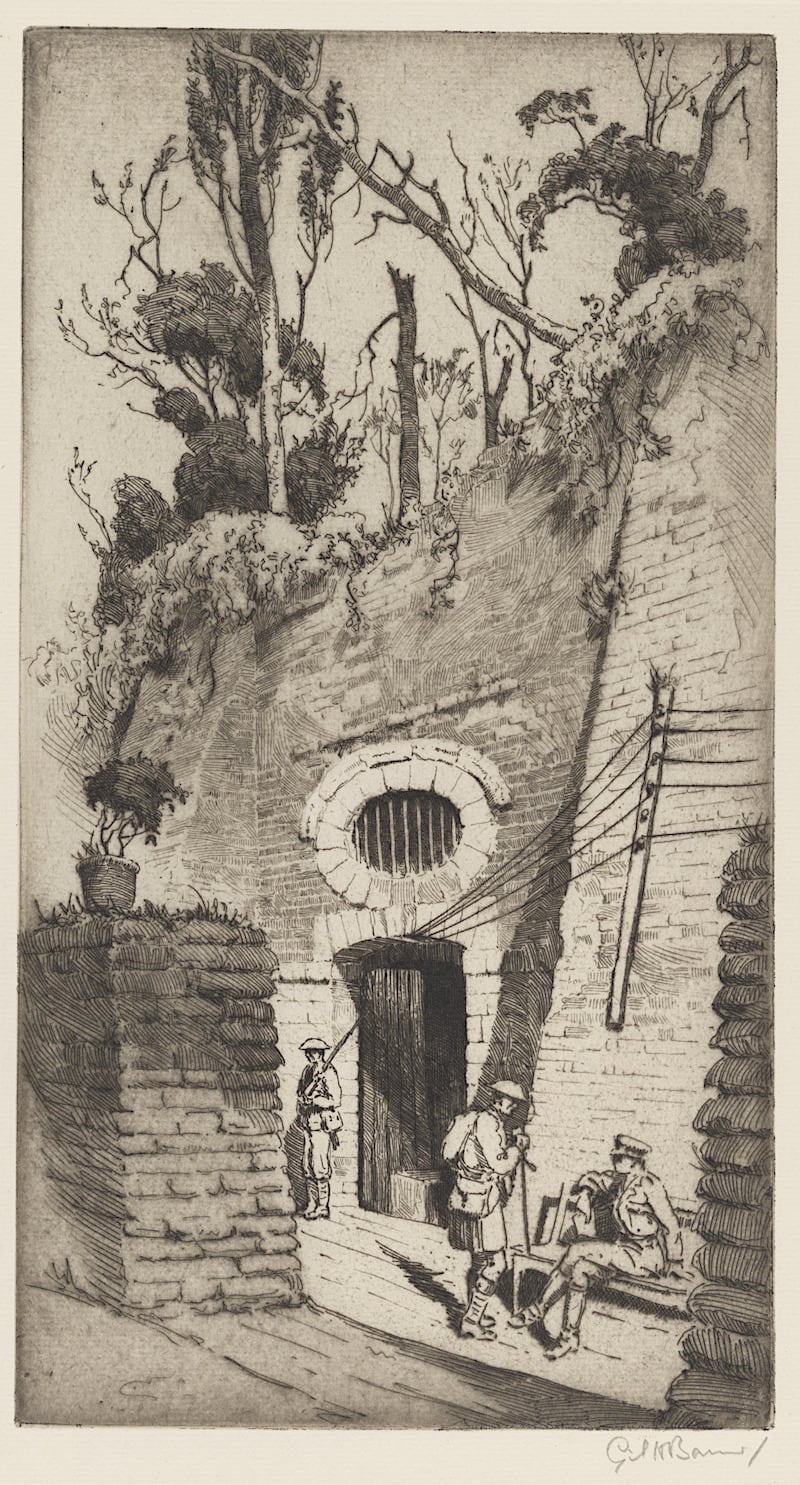
In a letter dated 2 March 1916, he talks about his billet being a large tunnel in the ramparts of the town. Ward, censoring his own letters, provides not-too-hard-to-guess clues to the town's location: 'I believe you know it well: it has been the object of all eyes for a long time and pictures of its general ruins and especially those of a Cathedral and Cloth Hall' — which is of course, Ypres, and the 'Hotel' ramparts are the billets of the 12th Sherwood, the location infamously associated with the Wipers Times. He goes on to describe the billets as amply furnished with 'loot' — he later writes that the Cloth Hall provides 'many fine curios including carved oak panels', consisting of a large fireplace (though there is no chimney so it gets a bit smoky), armchairs, a folding desk, a piano, and proper beds with dressing tables and washing stands. There is electric lighting, a Decca Gramophone — with 'heaps' of records — though they preferred it, if someone was around, to play the piano, and Ward comments, 'If it was not for the sound of the guns, you would not realise where you were'.24
In this letter he makes his first reference to the Wipers Times, saying it is printed nearby in the town on an old printing machine they found along with type, ink and paper, and quite boastfully writes of the magazine saying, 'even Sir Douglas Haig has a copy'.25
Later, in May 1917, he writes that the battalion has returned to the area, and he refers to the billet as 'our old hotel' noting that it looks the same as ever with the piano (missing its frontispiece) and all the bunks still there.26
Wipers Times
It is always 'news' when he sends a copy of the paper to his parents; on the third issue he is quite adamant that they should let him know when they receive it as 'what bothers me about getting copies, is somebody might pinch them'.27 Every issue he sends is accompanied by a dose of excitement; on 30 July 1916, he writes that the upcoming issue 'will be the best we have ever done, mark my words'.28
Interestingly, William Beach Thomas is mentioned. As many commentators have pointed out, the Wipers regularly lampooned the Daily Mail writer with spoof articles by Teech Bomas. However, a letter from Wards, 18 September 1916, mentions they sent Thomas a copy of the Wipers and he provided a favourable review in the Daily Mail, also on 18 September 1916. This makes me wonder if there is more to this story, considering the friendly exchange with Sabretache from the previous article; did Thomas do something later that offended the Wipers staff, thus becoming a target of ridicule? This is a mystery for another day.29
Articles by Ward
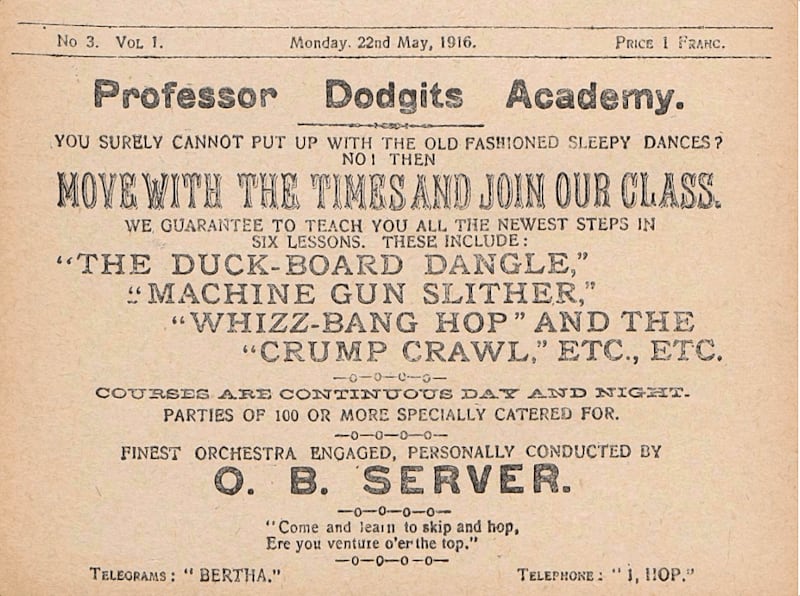
The Professor Dodgits advert (Figure 5) is directly mentioned in his letter of 25 May 1917 and he asks his parents for their opinion on it, explicitly calling it 'my advert'.30 This appears to be the only direct reference to something he has contributed. It is worth considering that he also sent a number of postcards which are not in the archives, and the copies of Wipers Times were sent as parcels. Based on my own experience, on the rare occasions I have had something published, I know if I send something I will most likely add a quick note, such as 'check out page 45', and I wonder if Ward may have done the same. There are, however, some other clues to what he may have contributed, and I certainly do not believe this was the only advert or contribution he came up with for the paper, based on his enthusiasm. In a later letter, 19 October 1917, he writes, 'I've half promised an advert or something, but don't yet know if my brains will run to it. nous verrons ce que nous verrons (we shall see what we shall see)'.31
Possible other contributions by Ward include 'The Mystery of 999' by Cockles Tumley (16 April 1916). He asks his parents if they recognise it as it's a 'skit on Horatio's Bottomley's article 666 from the Sunday paper'.32 On the identity of 'Cockles Tommy', Peter Cook has speculated that the author must have had some classical knowledge , as Cockles was the surname of Horatius who saved Rome by defending a bridge — Ward demonstrates he has had a classical education as his often quotes Latin — but then again, so does every Officer who had a public school education (which was almost all of them) and who would have studied the classics.33
In the archive, the poem the Night Hawks by A. Pioneer (12 February 1916) is catalogued as being possibly by Ward and the included copy of the relevant Wipers issue has pencil marks changing the 8th verse, 3rd line, from beginning with 'Reciting' to 'Recall' — interestingly in the facsimile versions this is different again, starting with 'Recalling' — suggesting more than one print-run.34
Ward on Roberts
Ward spoke very highly of Roberts in his letters and refers to him as 'High Chief'. In a testament to Roberts' charismatic personality, he writes that he is pleased that he has an autographed photo of him and calls him a 'Perfect Genius'.35 He also sends, in approval, a 'good little rhyme' that was made up by Roberts:
Rome wasn't built in a day:
Eve didn't ride in a 'bus
Half the worlds in sandbags,
And the rest of it's on us.36
In a later letter, he mentions sending Col. Roberts a peace offering in the form of a Christmas turkey — the reason why there may have been some drama is not in the letters I chose to focus on, but the impression is that it was minor event, as in the same letter he speaks enthusiastically about the battalion's Christmas card, 'Peace and Goodwill', and he suspects Roberts of being its author.37
Roberts was not always the editor and other contributors identified
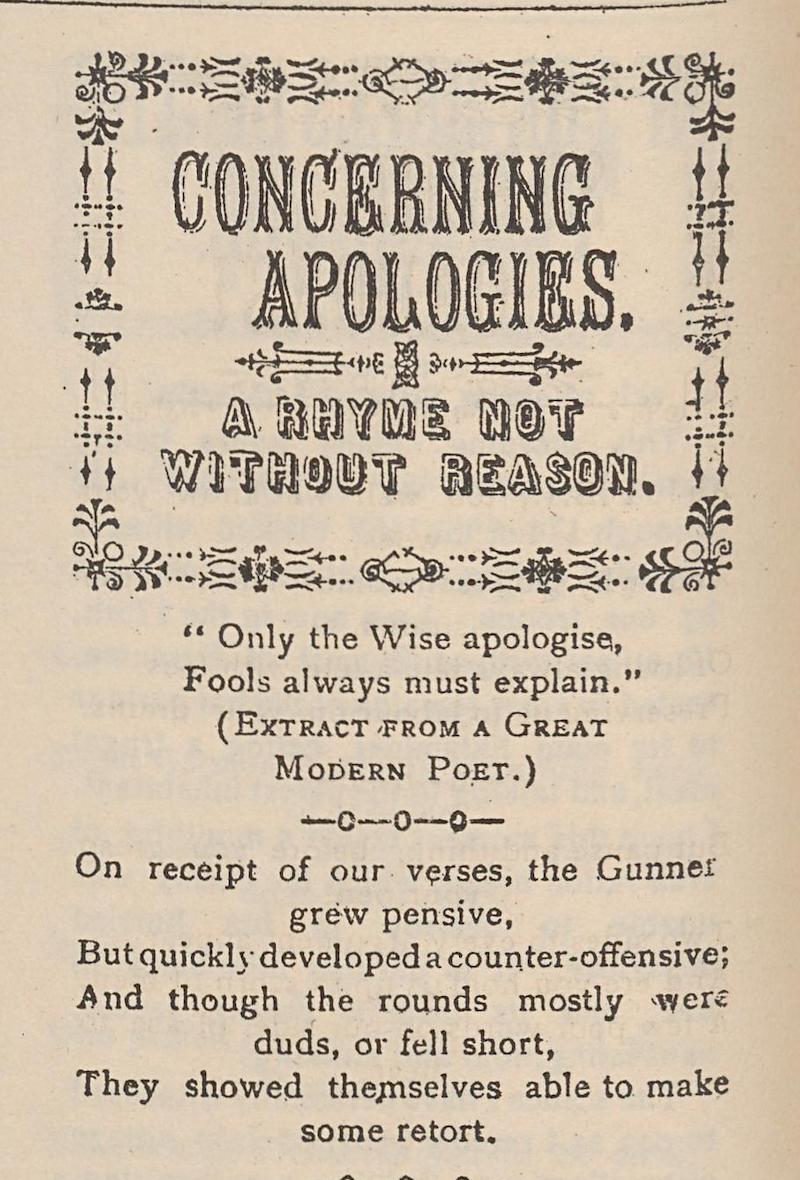
A letter dated 31 May 1916 provides two important pieces of information. The first is he talks about nicknames. This is in reference to the Professor Dodgit (Figure 3) character he created and the Wipers in general. He says:
'If I could explain it to you, you would enjoy it all the more: the same of course with the other quips and jokes which convey nothing to you, but mean a lot to us, since each name is a parody or nickname for someone we all know out here'.38
He then lists the lead staff on the paper: Roberts as Editor, Pearson as sub-editor, and Mohr as publisher.
Mohr was 2nd Lieutenant (later Captain) Stanley Melbourne Mohr. He would later go on to be awarded the Military Cross in November 1916 for conspicuous gallantry in action, showing great skill and determination in constructing a trench under heavy fire.39 Mohr was not the only publisher to be identified. In the issues of the Wipers Times he sent home, the very first issue, 12 February 1916, is signed not only by Roberts and Pearson, but under the space for publisher, it is signed by R.D.B Woods.40 Woods was 2nd Lieutenant (later Lieutenant) Richard Donald Bell Woods. I also found from a separate source (see below) that a later publisher on the magazine was Captain W.J. Asher, and while this sounds 'bloody obvious' typing it out, it is worth remembering, there was a war on, and the Wipers Times was produced around the duties of the men — it is therefore unsurprising to see changes in the paper's staff.
On 17 April 1917, Ward says he is sending the latest copy of the paper (believed to be 10 April 1917) and notes that although Roberts is now CO and he is too busy to actually edit the magazine, he did write a great many articles for this specific issue. He further adds that 'Gunner' is the new editor. 41 His parents think that Ward is in fact 'Gunner', and he corrects them in a letter dated 26 April 1917, saying: 'The "Gunner" of course is not me but the nickname of Capt. S.M. Mohr M.C., originated through the boxer I believe, Gunner Moir'.42 A couple of notes on this. I was under the impression that Pearson took over when Roberts was promoted, but this does not seem to be the case (or perhaps it happened later?). Secondly, 'Gunner' has quite a few mentions in the Wipers, and with this new info in mind, examples (as in Figure 6) begin to make a lot more sense.
Summary
For me, finding the reference to 'Violets' Chronicle of Fashion' has been the main takeaway. It has also been very interesting to read through the letters of someone involved in the production of a trench journal. I know instances are very rare, and off the top of my head I can only think of Keeling Letters and Recollections — an edited collection of the letters of Sergeant-Major Keeling, 6th Battalion Duke of Cornwall Light Infantry, who was the editor on the journal The Red Feather.43
From researching Ward's letters, several other leads have also appeared regarding the Wipers Times as well as a couple of flags. In terms of leads — and I will be writing this up in a future post once I have had the opportunity to investigate them — I have come across the fact that the Wipers presses were not just used to print the magazine: they were also used to print other items such as concert party programmes. To go with the 'line-up' photo above, I also have a potential 'witness list' — including a lead on a TV interview that was carried out in the 1960s with two members of the Sherwood Foresters.
In terms of 'flags', the first involves the timeline of the publication, very minor, but a few discrepancies appear when comparing Ward's version of events with other accounts. I want to pull together accounts from my wider research into one place to be able to compare — I am expecting to find clarification rather than revelation. The second flag is a bit more concerning and involves one of the Sergeants in the regiment who may or may not have been involved in the publishing of the Wipers, which is going to take a bit more research to establish the facts.
And, of course, the quest to establish the identity of Violet continues.
-
Nottinghamshire Archives, DD2402/1, Lieutenant Ward Letters. ↩︎
-
NA, DD2402/1/43, Letters of Thomas Ward, 16 May 1916, NA, DD2402/1/50-52, Letters of Thomas Ward, 28 May 1916. ↩︎
-
NA/DD2402/1/148-150, Lieutenant Ward Letters, 11 October 1916. ↩︎
-
Nottingham Journal, 4 November 1947, p.4. ↩︎
-
NA/ DD2402/2, Summary of Lieut. T.M.E. Ward Letters. ↩︎
-
Nottingham Journal, 31 August 1938, p.3; NA, DD2402/1/50-52, Letters of Thomas Ward, 28 May 1916. ↩︎
-
NA/ DD2402/2, Summary of Lieut. T.M.E. Ward Letters. ↩︎
-
NA/DD2402/1/008-009, Lieutenant Ward Letters, 05 March 1916. ↩︎
-
NA/DD2402/1/292-294, Lieutenant Ward Letters, 24 March 1917. ↩︎
-
NA/DD2402/1/228-230, 26 January 1917. ↩︎
-
He actually refers to another book by Oxenham without giving its title before mentioning Bees in Amber, NA/DD2402/1/362-265, 22 June 1917. ↩︎
-
NA/DD2402/1/124, 6 September 1916. ↩︎
-
NA/DD2402/1/268-276, 09 March 1917. ↩︎
-
NA/DD2402/1/028, 20 April 1916. ↩︎
-
NA/DD2402/1/028, 20 April 1916. ↩︎
-
NA/DD2402/1/028, 20 April 1916. ↩︎
-
NA/DD2402/1/228-230, 26 January 1917. ↩︎
-
NA/DD2402/1/299-300, 2 April 1917. ↩︎
-
NA/DD2402/1/219-221, 16 January 1917. ↩︎
-
NA/DD2402/1/305-307, 9 April 1917. ↩︎
-
NA/DD2402/1/004-007, Lieutenant Ward Letters, 02 March 1916. ↩︎
-
NA/DD2402/1/014-015, Lieutenant Ward Letters, 05 March 1916. ↩︎
-
NA/DD2402/1/200-201, Lieutenant Ward Letters, 12 December 1916. ↩︎
-
NA/DD2402/1/004-007, Lieutenant Ward Letters, 02 March 1916. ↩︎
-
NA/DD2402/1/004-007, Lieutenant Ward Letters, 02 March 1916. ↩︎
-
NA/DD2402/1/343, Lieutenant Ward Letters, 26 May 1917. ↩︎
-
NA/DD2402/1/008-009, Lieutenant Ward Letters, 05 March 1916. ↩︎
-
NA/DD2402/1/112, Lieutenant Ward Letters, 30 July 1916. ↩︎
-
NA/DD2402/1/128-130, Lieutenant Ward Letters, 20 September 1916. ↩︎
-
NA/DD2402/1/048-049, Lieutenant Ward Letters,25 May 1916. ↩︎
-
NA/DD2402/1/167-170, Lieutenant Ward Letters,19 October 1916. ↩︎
-
NA/DD2402/1/028, Lieutenant Ward Letters,20 April 1916. ↩︎
-
NA/DD2402/1/313-314, Thomas Ward Letters, 31 May 1916; https://www.westernfrontassociation.com/world-war-i-articles/hooge-in-the-the-wipers-times/, retrieved 30 May 2023. ↩︎
-
NA/DD2402/3/001, 'The Wipers Times' or 'Salient News' No.1 Volume 1' ↩︎
-
NA/DD2402/1/148-150, Lieutenant Ward Letters, 11 October 1916; NA/DD2402/1/053-054, Lieutenant Ward Letters, 31 May 1916. ↩︎
-
NA/DD2402/1/018-019, Lieutenant Ward Letters, 26 March 1916. ↩︎
-
NA/DD2402/1/424, Lieutenant Ward Letters, 23 December 1917. ↩︎
-
NA/DD2402/1/053-054, 31 May 1916. ↩︎
-
Derbyshire Advertiser and Journal, 18 November 1916. ↩︎
-
NA/DD2402/3/001, 'The Wipers Times' or 'Salient News' No.1 Volume 1' ↩︎
-
NA/DD2402/1/313-314, Lieutenant Ward Letters, 31 May 1916. ↩︎
-
NA/DD2402/1/320-322, Lieutenant Ward Letters, 17 April 1916, James 'Gunner Moir' Moir (1879-1939) was a famous English heavyweight boxer who was British champion between 1906 and 1909. ↩︎
-
E.T. Keeling Letters and Recollections (London: George Allen, 1918). ↩︎
Posts in this series
- The Wipers Times Exposé: A Picture of Dorothy Violet Hall emerges
- The Wipers Times Exposé: The Actor, Avesnes, and the Forgotten Evening Edition of the Wipers Times
- The Wipers Times Exposé: The Printer and the Presses
- The Wipers Times Exposé: Staff, Suspects, and Witnesses
- The Wipers Times Exposé Addendum: Conclusive Proof, the Letters of Thomas Moore Emmanuel Ward, and Other Contributors Identified
- The Wipers Times, Tatler, and the Identity of ‘Violet’ from Violet’s Chronicle of Fashion: An Exposé